Choosing between Gate.io and Bybit can be tough when you’re looking for a crypto exchange in 2025. Both platforms offer different features and benefits that might suit various trading needs and styles. You’ll want to understand how they compare before deciding where to put your money.
Bybit scores higher overall with an 8.0 rating compared to Gate.io, making it particularly appealing for active traders seeking fast crypto purchases and derivatives trading. The platform is known for its straightforward approach and speed, which can be crucial when you’re making time-sensitive trading decisions.
Gate.io, on the other hand, offers its own set of advantages that might better match what you’re looking for. As you compare these exchanges, you’ll need to consider factors like fees, available cryptocurrencies, security features, and user experience. Both platforms have earned their place among top cryptocurrency exchanges, but your personal trading goals will determine which is the better fit.
Overview of Gate.io
Gate.io is a global cryptocurrency exchange established in 2013 that offers trading services for a wide range of digital assets. The platform has grown to become one of the top exchanges by trading volume while expanding its features to serve both beginners and advanced traders.
History and Reputation
Gate.io began operations in 2013, making it one of the longer-running exchanges in the cryptocurrency space. Initially launched as Bter.com, the platform rebranded to Gate.io in 2017 to expand its global reach and services.
The exchange has built a mixed reputation over the years. While it has recovered from a security breach in 2015, it has since strengthened its security protocols. Gate.io now serves users in over 130 countries worldwide.
As a veteran in the crypto industry, Gate.io has maintained steady growth through multiple market cycles. The platform has earned trust by focusing on compliance with regulations across different jurisdictions, though availability varies by region due to regulatory requirements.
Services and Features
Gate.io offers a comprehensive suite of cryptocurrency services. The platform supports trading for over 1,400 cryptocurrencies with various trading pairs, appealing to those seeking both mainstream and newer tokens.
Key features include:
- Spot trading with competitive fees
- Futures trading with up to 100x leverage
- Copy trading for beginners to follow successful traders
- Lending services to earn interest on crypto holdings
- Staking options for passive income
- NFT marketplace for digital collectibles
The exchange also provides automated trading tools and a mobile app for trading on the go. Their interface caters to experienced traders with advanced charting tools but might be overwhelming for beginners.
Security Measures
Gate.io implements multiple security layers to protect user funds and data. The exchange stores most assets in cold wallets, keeping them offline and away from potential hackers.
Security features include:
- Two-factor authentication (2FA)
- Anti-phishing codes for emails
- Advanced encryption for data protection
- Regular security audits by third parties
- Insurance fund to protect user assets
The platform has introduced a Proof of Reserves system that allows you to verify that your deposits are fully backed. This transparency measure helps build trust with users concerned about exchange solvency.
Gate.io also employs strict KYC (Know Your Customer) verification processes to prevent fraud and comply with global regulations.
Overview of Bybit
Bybit is a cryptocurrency exchange known for its user-friendly platform and focus on derivatives trading. Founded in 2018, it has quickly grown to become one of the leading crypto exchanges globally with millions of users across more than 160 countries.
Company Background
Bybit was established in March 2018 by Ben Zhou, who previously worked at XM, a forex trading company. The exchange is headquartered in Dubai after relocating from Singapore in 2022.
Initially, Bybit focused exclusively on cryptocurrency derivatives trading but has since expanded its offerings considerably. The platform gained popularity during the 2020-2021 bull run, attracting traders with its robust infrastructure and low latency trading engine.
Today, Bybit serves over 20 million registered users worldwide. The company employs hundreds of staff across multiple offices globally and continues to expand its reach in the cryptocurrency market.
Trading Options
Bybit offers a comprehensive suite of trading products suitable for both beginners and experienced traders:
- Spot Trading: Buy and sell cryptocurrencies directly at current market prices
- Derivatives Trading: Includes futures contracts, perpetual contracts, and options
- Copy Trading: Follow and automatically copy successful traders’ strategies
- Earn Products: Staking, savings accounts, and other yield-generating options
The platform supports over 500 cryptocurrencies and trading pairs. Bybit’s interface is designed to be intuitive while still offering advanced charting tools and order types.
Trading fees on Bybit are competitive, with maker fees as low as 0.01% and taker fees starting at 0.06%. The fee structure uses a tiered system based on your 30-day trading volume.
Safety Protocols
Bybit implements multiple security measures to protect user funds and data. The exchange stores the majority of user assets in cold wallets, keeping them offline and safe from potential cyber attacks.
Two-factor authentication (2FA) is mandatory for all accounts, providing an additional layer of security. Bybit also employs real-time monitoring systems to detect suspicious activities.
The platform includes risk management tools like insurance funds to prevent auto-liquidations during extreme market volatility. These funds help maintain market stability and protect traders.
Bybit is working toward regulatory compliance in multiple jurisdictions. While not yet fully regulated in all markets, the exchange follows AML (Anti-Money Laundering) and KYC (Know Your Customer) protocols in applicable regions.
Gate.io vs Bybit: Comparison of Interface and Usability
The trading platform’s interface and ease of use can significantly impact your trading experience. Both Bybit and Gate.io offer distinct approaches to user interface design and accessibility features.
User Experience
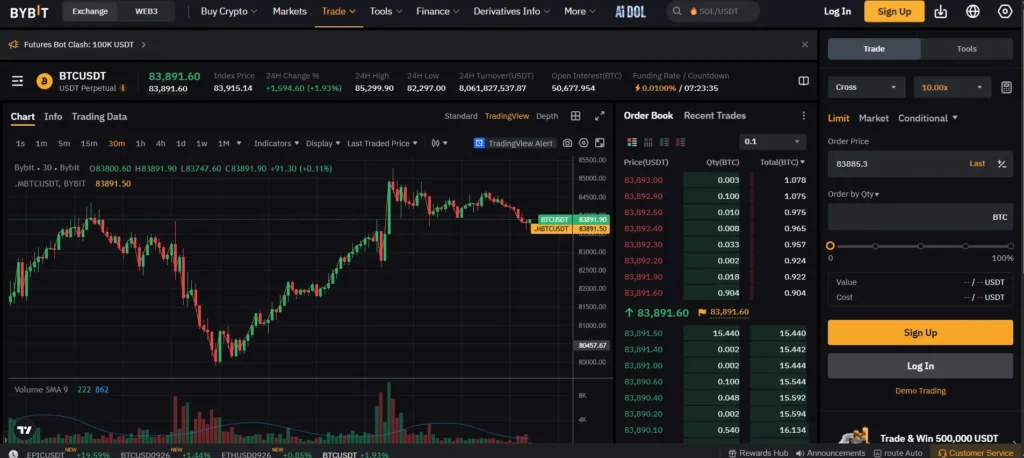
Bybit offers a more user-friendly interface that caters to both beginners and experienced traders. The dashboard layout is clean and intuitive, making it easy to navigate between different sections. The trading view presents essential information like price charts, order books, and trade history in a well-organized manner.
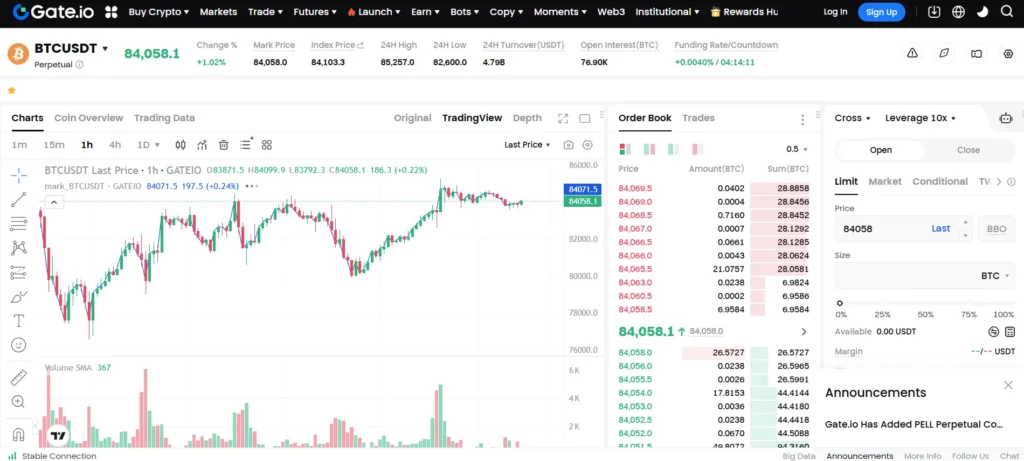
Gate.io’s interface is more complex and feature-rich, which might overwhelm new users. The platform packs numerous functions and tools into its interface, creating a steeper learning curve. However, experienced traders might appreciate the depth of information available at a glance.
Bybit excels in customization options, allowing you to tailor the interface to your preferences. You can rearrange widgets, adjust chart settings, and save multiple layout configurations.
Mobile Accessibility
Both exchanges offer mobile apps for iOS and Android devices, but with notable differences in functionality and design.
Bybit’s mobile app maintains most features from the desktop version while adapting them for smaller screens. The app has an intuitive navigation system with a bottom menu bar providing quick access to essential functions. Charts are responsive and support multiple timeframes and indicators, making on-the-go analysis possible.
Gate.io’s mobile application offers comprehensive functionality but can feel cluttered on smaller screens. The app includes advanced features like spot and futures trading, staking options, and lending services.
Push notifications are available on both platforms, alerting you to price movements, completed orders, and account activities. Bybit’s app tends to be more stable with fewer reported crashes and technical issues compared to Gate.io.
Gate.io vs Bybit: Supported Cryptocurrencies
Both Gate.io and Bybit offer a wide range of cryptocurrencies, but they differ significantly in their selection. Gate.io stands out with its vast array of altcoins, while Bybit focuses on popular tokens with strong trading volume.
Gate.io Offerings
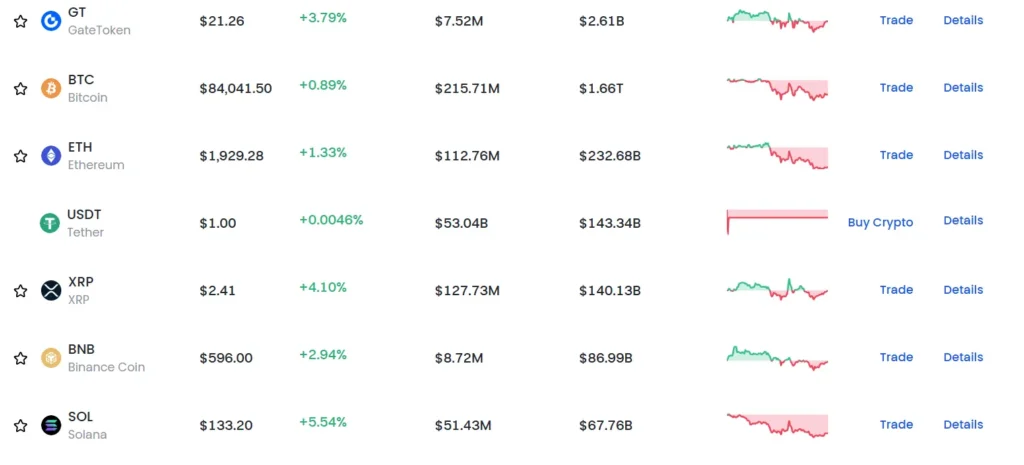
Gate.io boasts an impressive selection of over 3,700 cryptocurrencies and stablecoins. This extensive range makes it an attractive option if you’re looking to invest in lesser-known altcoins or emerging projects.
The platform supports all major cryptocurrencies like Bitcoin, Ethereum, and Dogecoin, but its real strength lies in its vast selection of smaller market cap tokens. You’ll find numerous DeFi tokens, gaming coins, and new blockchain projects that aren’t available on many other exchanges.
Gate.io regularly adds new listings, often being among the first major exchanges to support emerging cryptocurrencies. This can be valuable if you’re interested in getting in early on promising projects before they reach larger exchanges.
Bybit Offerings
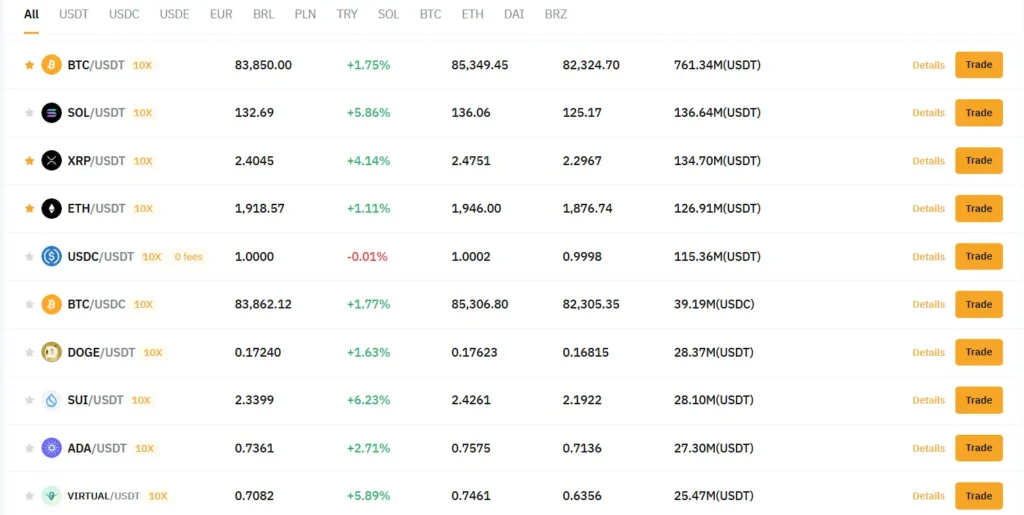
Bybit offers a more focused selection of cryptocurrencies compared to Gate.io. The platform prioritizes quality over quantity, listing around 400+ cryptocurrencies with strong market presence and trading volume.
You’ll find all major cryptocurrencies like Bitcoin and Ethereum, along with popular altcoins and stablecoins. Bybit is particularly strong in its derivatives offerings, with numerous trading pairs for futures and options contracts.
The exchange is more selective with new listings, typically adding cryptocurrencies only after they’ve demonstrated market stability and demand. This approach helps you avoid potentially risky or unproven tokens.
Bybit’s cryptocurrency selection is well-suited if you’re a trader who prefers focusing on established coins with good liquidity rather than exploring the frontier of new token offerings.
Gate.io vs Bybit: Fees Structure
Both Gate.io and Bybit have different fee structures that impact your trading costs. Understanding these fees is essential for maximizing your profits, especially if you’re an active trader.
Trading Fees
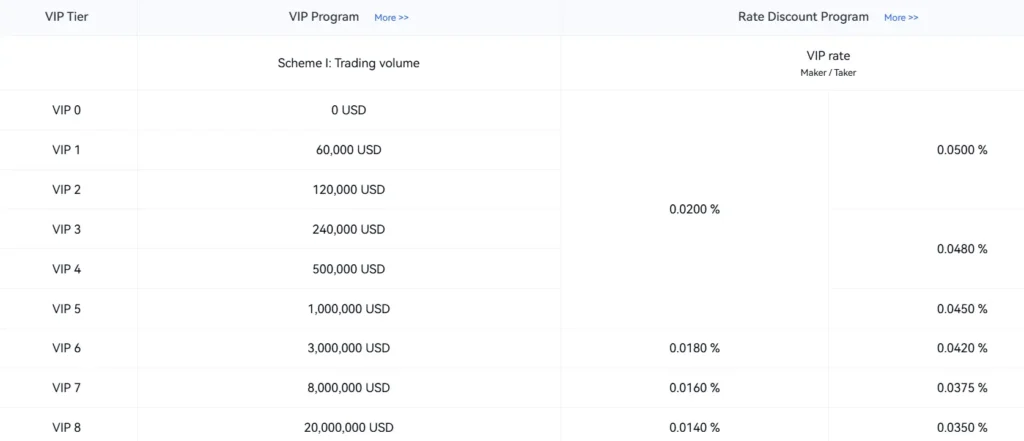
Gate.io offers a competitive fee structure with standard spot trading fees at 0.09% for both makers and takers. This flat rate is lower than many competitors in the market. For high-volume traders, Gate.io provides tiered discounts that can reduce your fees further.
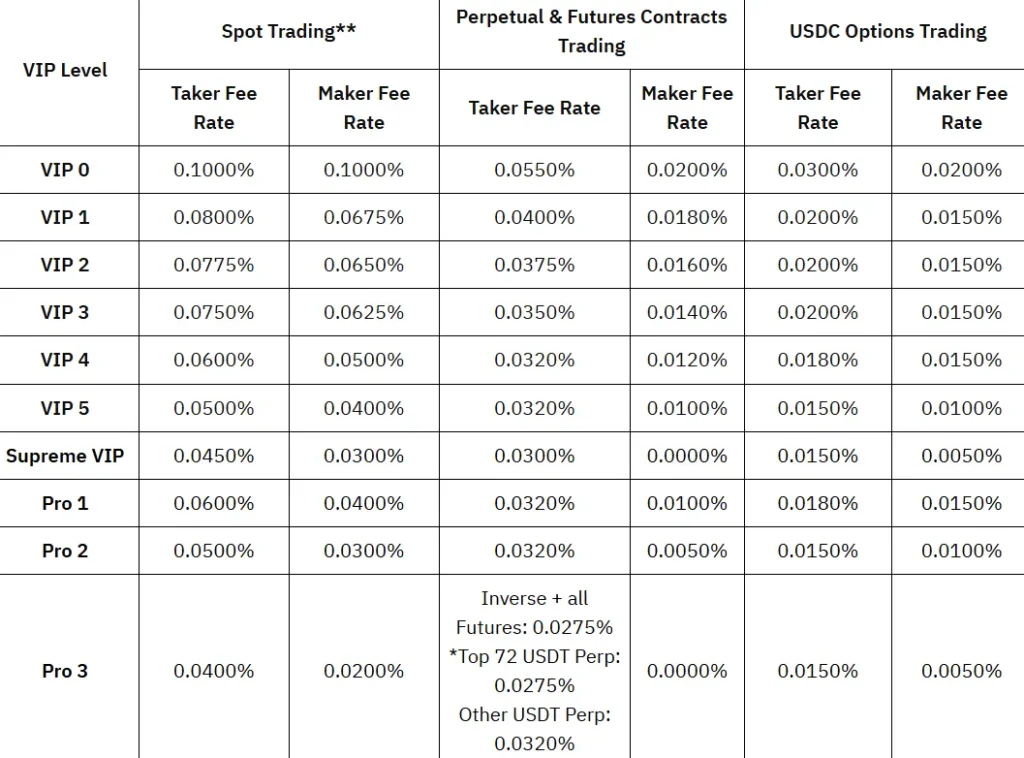
Bybit’s standard spot trading fee is slightly higher at 0.1% for makers and 0.1% for takers. However, Bybit shines in the derivatives market with maker fees as low as 0.01% for futures trading. VIP members on Bybit can access even lower rates, paying only 0.018% or less for perpetual contracts.
Active traders on Bybit benefit from the tiered structure, with fees potentially dropping to 0.055% for maker orders as your trading volume increases. This makes Bybit particularly attractive if you frequently trade derivatives.
Withdrawal Fees
Withdrawal fees on both platforms vary by cryptocurrency. Gate.io typically charges network fees plus a small processing fee. These fees are dynamic and adjust based on blockchain network congestion.
Bybit’s withdrawal fees are generally competitive and sometimes lower than Gate.io for certain cryptocurrencies. For example, Bitcoin withdrawals might cost you around 0.0005 BTC on Bybit.
Both exchanges occasionally run promotions with reduced or waived withdrawal fees. You should check the current fee schedule on each platform before making large withdrawals.
Neither platform charges deposit fees, which is standard across most crypto exchanges. Both Gate.io and Bybit update their withdrawal fee structures regularly to account for network changes and cryptocurrency price fluctuations.
Gate.io vs Bybit: Liquidity and Trading Volume
When comparing Gate.io and Bybit, liquidity and trading volume are key factors that affect your trading experience. Both exchanges handle significant daily trading volumes, though Bybit typically processes larger volumes than Gate.io.
As of March 2025, Bybit ranks higher among top cryptocurrency exchanges by volume according to industry trackers. This higher volume often translates to better liquidity for popular trading pairs.
What does better liquidity mean for you? It means:
- Faster trade execution with less slippage
- Tighter bid-ask spreads on most pairs
- Easier entry and exit for large positions
Gate.io still maintains respectable liquidity, especially for altcoins and some niche tokens that may not be available on Bybit.
The 24-hour trading volumes fluctuate daily, but Bybit consistently maintains stronger volume for major pairs like BTC/USDT and ETH/USDT. Gate.io’s strength lies in its wide selection of trading pairs, offering liquidity across many smaller market cap tokens.
Bybit’s trading fee percentage is also slightly lower at up to 0.1%, which can be advantageous when trading large volumes. This fee advantage combines with higher liquidity to provide a more cost-effective trading environment for most users.
Remember that liquidity conditions can change based on market volatility, so always check current conditions before executing large trades on either platform.
Gate.io vs Bybit: Customer Support and Service
When choosing between Gate.io and Bybit, customer support can make a big difference in your trading experience. Both platforms offer support options, but there are some key differences.
Bybit provides 24/7 customer support through live chat. This means you can get quick answers whenever you have questions. Their support team is known for responding promptly to user concerns.
Gate.io also offers customer service, but based on user feedback, response times may vary. They provide support through multiple channels including email and ticket systems.
Support Options Comparison:
| Feature | Bybit | Gate.io |
|---|---|---|
| 24/7 Support | Yes | Yes |
| Live Chat | Yes | Limited |
| Email Support | Yes | Yes |
| Response Time | Generally fast | Variable |
| Language Options | Multiple | Multiple |
Both exchanges offer help centers with FAQs and guides. These resources can help you solve common problems without contacting support directly.
User reviews suggest Bybit may have an edge in customer service quality. Their focus on responsive support has helped build trust with their user base.
For new traders, good support is especially important. You’ll want clear answers when learning how to use trading features or resolving account issues.
Consider your support needs when choosing between these platforms. If immediate assistance is important to you, Bybit’s live chat option might be more suitable.
Gate.io vs Bybit: Derivatives Trading
Both Bybit and Gate.io offer robust derivatives trading platforms with various contract types. These exchanges provide traders with opportunities to leverage their positions and potentially increase profits, though with higher risk.
Perpetual Contracts
Bybit has built a strong reputation in the perpetual contracts market. You can trade popular crypto pairs like BTC/USDT and ETH/USDT with leverage up to 100x on Bybit. The platform offers a user-friendly interface that makes it easier to manage your positions.
Gate.io also provides perpetual contracts but with leverage typically capped at 50x for most trading pairs. Their perpetual contract system includes a funding rate mechanism that helps maintain the contract price close to the spot price.
Both platforms offer cross and isolated margin modes, allowing you to choose your risk level. Bybit’s liquidation engine is often praised for being more trader-friendly, gradually reducing positions rather than liquidating all at once.
Futures Contracts
Bybit offers quarterly futures contracts on major cryptocurrencies. These contracts have specific expiration dates and settlement terms. You can trade with up to 100x leverage, depending on the contract and your account tier.
Gate.io provides a wider variety of futures contracts, including quarterly and bi-quarterly options. Their platform supports more trading pairs in the futures market compared to Bybit.
One advantage of Gate.io is their innovative features for futures trading, including portfolio margin which allows you to use your entire account balance as collateral.
Trading fees are competitive on both platforms, with discounts available for high-volume traders. Bybit typically charges 0.06% for takers and 0.01% for makers, while Gate.io’s fees vary by contract type.
Gate.io vs Bybit: Financial Security and Insurance
When comparing Gate.io and Bybit, financial security should be a top priority for your crypto investments. Both exchanges have implemented security measures, but there are important differences to consider.
Bybit currently faces challenges after a major security incident in February 2025, when over $1.5 billion in assets were stolen. This raises serious concerns about their security protocols.
According to recent search results, Bybit does not mention insurance coverage for user funds. In fact, their terms explicitly state “there’s no insurance” for accounts.
Gate.io provides a more secure trading environment with several protective measures in place. Their platform includes multi-signature wallets and cold storage options to safeguard your assets.
Key Security Features Comparison:
| Feature | Gate.io | Bybit |
|---|---|---|
| Cold Storage | Yes | Yes |
| Insurance Fund | Limited | Not mentioned |
| Security Incidents | Minor | Major ($1.5B theft in 2025) |
| Two-Factor Authentication | Yes | Yes |
You should always enable all available security features on whichever platform you choose, including:
- Strong, unique passwords
- Two-factor authentication
- Email notifications for withdrawals
- IP restrictions where available
Remember that while exchanges implement security measures, they can still be vulnerable to attacks. Consider using hardware wallets for long-term storage of significant crypto holdings.
Gate.io vs Bybit: Regulatory Compliance and Legalities
Both Gate.io and Bybit operate in the complex world of cryptocurrency regulation, which varies significantly by country. Understanding their compliance status is crucial before you choose an exchange.
Gate.io has worked to become a regulatory-compliant exchange. According to recent information, they’ve established a robust security framework designed to meet regulatory requirements across different jurisdictions.
Bybit has faced regulatory challenges in some regions. They’ve had to adjust their services in certain countries to comply with local laws.
Important considerations for you:
- Geographic restrictions: Both exchanges limit services in certain countries
- KYC requirements: Both implement Know Your Customer procedures
- Trading limitations: Regulatory status may affect which cryptocurrencies are available to you
Before creating an account with either exchange, verify they operate legally in your country. Regulations change frequently in the crypto world.
Neither exchange is available to U.S. residents due to strict regulatory requirements. This is a significant limitation if you’re based in the United States.
Always check the most current regulatory status before depositing funds. The cryptocurrency regulatory landscape continues to evolve as governments develop clearer frameworks for digital assets.
Gate.io vs Bybit: Community and Educational Resources
Both Gate.io and Bybit offer support for their users through community engagement and learning materials. These resources help traders of all levels improve their skills and stay informed.
Bybit stands out with its comprehensive “Learn” section. This area provides valuable resources specifically designed for beginner traders wanting to develop their trading skills.
Gate.io offers innovative features and maintains active community forums. These spaces allow users to share strategies, ask questions, and connect with other traders.
Both platforms maintain a presence on social media channels like Twitter, Telegram, and Discord. These channels provide updates on new features, market trends, and upcoming events.
Bybit offers regular webinars and trading tutorials that cover basic and advanced concepts. They also publish market analysis to help you make informed decisions.
Gate.io provides educational content focused on their unique features and trading tools. Their resources help users understand margin trading and other platform-specific functions.
For beginners, Bybit’s educational resources may be more accessible and comprehensive. Their learning materials use simpler language and cover fundamentals thoroughly.
Both platforms offer documentation on how to use their features, but the quality and organization differ. Bybit’s guides tend to be more user-friendly with clearer instructions.
When choosing between these exchanges, consider which community and educational style matches your learning preferences and trading goals.
Frequently Asked Questions
Below are answers to common questions traders have when comparing Gate.io and Bybit. These platforms differ in several key aspects that might influence your choice depending on your specific trading needs.
What are the differences in trading fees between Gate.io and Bybit?
Bybit generally offers more competitive trading fees compared to Gate.io. Bybit’s standard maker fees start at 0.01% while taker fees begin at 0.06%.
Gate.io’s fee structure is slightly higher with standard maker fees at 0.02% and taker fees at 0.08%. Both exchanges offer fee discounts based on trading volume and native token holdings.
VIP traders on both platforms can access significantly reduced fees, but Bybit typically provides better rates for high-volume traders.
How do Gate.io and Bybit compare in terms of available cryptocurrencies?
Gate.io supports a wider range of cryptocurrencies than Bybit. Gate.io lists over 1,400 different tokens and trading pairs, making it ideal if you’re looking for newer or less common altcoins.
Bybit offers around 300+ cryptocurrencies, focusing more on established coins and tokens. While this selection is smaller, it covers all major cryptocurrencies and popular altcoins.
Both platforms regularly add new listings, but Gate.io is typically faster to list emerging projects and tokens.
Which platform offers a better user experience, Gate.io or Bybit?
Bybit provides a more intuitive and user-friendly interface compared to Gate.io. Bybit’s platform is designed with a cleaner layout that makes navigation simpler for beginners.
Gate.io’s interface contains more features and options, which can be overwhelming for new users but appreciated by experienced traders who want advanced functionality.
Bybit’s mobile app receives higher ratings than Gate.io’s app, with users praising its responsiveness and stability during high market volatility.
What security measures do Gate.io and Bybit implement to protect user assets?
Both exchanges employ strong security protocols including two-factor authentication, cold storage for the majority of funds, and regular security audits.
Gate.io has demonstrated excellent security practices and transparency, actively helping other exchanges (including Bybit) with security matters. They maintain a Proof of Reserves system allowing users to verify their assets.
Bybit uses a comprehensive risk management system and multi-signature wallets. Neither exchange has suffered any major security breaches affecting user funds, though both have faced minor incidents.
Can United States residents legally use Gate.io or Bybit for trading?
Neither Gate.io nor Bybit currently allows full trading services for United States residents due to regulatory constraints. Both platforms have geoblocking measures in place.
Gate.io offers a separate platform called Gate.us for American users, but with limited features compared to the international version.
Bybit has completely withdrawn from the U.S. market and doesn’t provide an alternative platform for American users. You should verify the current regulatory status before attempting to use either platform.
How do the liquidity and trading volumes on Gate.io compare with those on Bybit?
Bybit typically maintains higher liquidity and trading volumes than Gate.io, especially for futures and perpetual contracts. This results in tighter spreads and less slippage on major trading pairs.
Gate.io offers good liquidity for spot trading across its wide range of cryptocurrencies, but may have thinner markets for some of its more obscure listings.
For popular cryptocurrencies like Bitcoin and Ethereum, both platforms provide sufficient liquidity for most traders, but Bybit’s higher overall volume makes it preferable for large trades.
